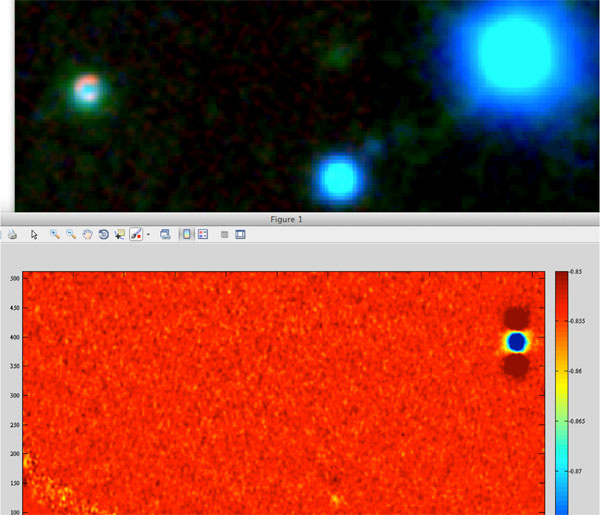Well, we tried out our faint guide star modes tonight. We locked on a 14th magnitude guide star in bin 3, and a 16th magnitude guide star in bins 4 and 5! We were getting down to 90 milli-arc-second PSFs in K-band, where diffraction-limited is 70 mas, while correcting fewer than 100 modes.
In this image we are locked on a 13th-magnitude guide star 24” from the galaxy (Clio image is below the finding chart). We would like to thank D.M. for the quick reduction and feedback on our faint guide star work. This is a big deal! We were able to lock the AO system on the correct faint star in the field, keep the galaxy on the chip, and deliver a 0.25 arc-second PSF in 1” seeing and 1.7 airmass (about 35 degrees up from the horizon) on a faint guide star for off-axis science!

OK, look. This is a blog about science and engineering, and occasionally animals. But we’re tired. We’ve been here for a long time. It’s all we can do to keep up with our data logs and the infinite list of things to test and implement. So the rest of today is quotes:
The VisAO Data Reduction team trying to figure out their rotator angles:
Laird: “It’s 90 degrees”
Kate: “It’s 270 degrees”
Jared: “It’s 27 degrees”
Laird: It’s 7 degrees”
Kate: “It’s 97 degrees”
Jared: It’s 180 degrees”
Alfio: “Well now I know why that galaxies book I read was heavy on the theoretical modeling and weak on the observations. Galaxies are hard to observe!”
Laird: “Unlike with this galaxy nonsense, we will be able to see the young stellar disk right away!”
Laird: “Guys, just between you and me… and don’t put this on the blog… but …”
Jared: “It’s ok. We have another problem.”
T.J.: “We’re ballpark exactly on the sweet spot.”
Jared: “OK, T.J., I’m about to start saving data here.”
T.J.: “I’ve *been* saving data.”
T.J.: “Squinting is like binning.”
Laird: “High-order AO used to be 8×8”
Jorge: “The sun is rising! I have to close the dome!” (Pause… go in dome… close dome… come back to control room) “…OK, good, no fire!”